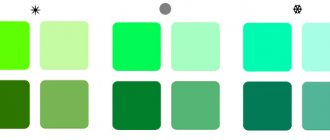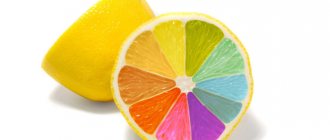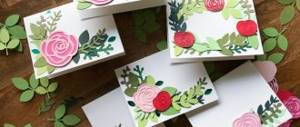The influence of color and light on the psychological state of a person.
Have you ever wondered why you choose clothes of a certain color scheme? Do you feel comfortable in orange or just black? Preferences in clothing and the interior color you choose can tell a lot of interesting things about your character traits and even your state of health. The language of color is universal; it is perceived equally regardless of nationality and culture.
Color influences play an important role in a person’s life: color can influence decision-making, change your reaction or cause it. Under the influence of a certain color, blood pressure may rise or appetite may decrease/increase. We do not focus on color in everyday life, and we understand the full importance of its impact only in the absence of colors: for example, on a cloudy, rainy day, we feel a decrease in mood, energy, depression, and the world around us seems unfriendly.
Color awakens an unconscious reaction in us, which may vary depending on the individual's personal characteristics. The color we prefer at a certain moment in life can tell a lot about ourselves: about our problems, fears, aspirations, etc. Even small children have their favorite colors: this can be easily determined by what toys kids play with most often. In most cases it is red.
There is an opinion that the attitude towards color is an innate characteristic of a person. Each individual has stable preferences that make up a “personal color scale” as one of the manifestations of individuality.
Thus, lovers of white easily fall into ecstasy, they have a well-developed imagination, and they are dreamy.
Lovers of the color pink are romantic, delicate natures. Violence in any form is completely unacceptable to them. Pink colors are preferred by people who spend their entire lives in the world of dreams, fairy tales and miracles. They love comfort and homeliness.
Admirers of the color red are power-hungry people who strive for leadership all their lives. They rarely suffer from remorse, being self-confident and ambitious. Red lovers want their emotional lives to become more intense. Aggression is the problem of such people.
Blue color is preferred by travelers, scientists, and religious figures. Dark blue is the color of artists. These people are very cheerful, energetic, and value success and wealth. Impressionable natures, affectionate, loyal, but easily discouraged in moments of failure.
Blue is the color of reasonable and self-confident people, but they have a certain vulnerability, especially noticeable in cases where they are trying to deceive them. Fans of blue are soft-hearted people who do not remain indifferent to the sorrows of others. But those who do not like the color blue are thus protesting against boredom and monotony.
Those who prefer the color brown have balance, thoroughness, and a thirst for knowledge. As a rule, they are distinguished by rigor and frugality. Brown is the color of mature age and thoughtful decisions.
Creative individuals gravitate towards gray tones. This color is considered cleansing. According to another opinion, those who prefer gray deliberately fence themselves off from external influences in order to maintain inner peace.
Green color is chosen by people who tend to withdraw into themselves. These people are warm-hearted, noble, and for the most part good parents and friends. Lovers of dark green are stubborn and persistent. Combined with gold, it is the color of bankers and successful people in business. They are respectable and respectable, they love nature and peace. The other pole is people who are straightforward, self-confident and have a desire to forcibly improve others.
Yellow is the color of reason and optimism. Yellow fans are cheerful people. The color yellow distinguishes an original, imaginative, creative and idealistic personality; it reveals a desire for independence and hope for a happy life.
Lovers of the color purple have a creative spirit. He attaches great importance to everything unusual and unconventional.
Color can be effectively used in interior decoration to improve performance, create conditions for relaxation, and improve mood. Psychologists advise that when choosing clothes, arranging an apartment, even when buying a car, you should focus not on current fashion, but on your own intuition. Colors that are too bright, flashy, and far from natural colors tire the eyesight and irritate the nervous system. Soft tones soothe and help restore strength.
Experts say that by changing the colors around you, you can significantly improve your well-being and your own life. When decorating the place where you spend the most time, use stimulating tones. Sometimes it is enough to hang a picture or place a small beautiful piece of interior design, the color spot of which will allow you to recharge with life-giving energy.
Prevention of nervous tension requires taking into account the nature of the effect of color on a person. The optimal range of colors that have the most beneficial effect on a person are green, yellow-green and green-blue colors. In addition to the physical properties of color (wavelength), its quality and aesthetic value must be taken into account. Monochromaticity should be avoided, since monotony is boring, causing, to use the terminology, “protective inhibition.”
Each color has its own energy and can even change our mood and physiological processes occurring in the body. There is a direction of unconventional therapeutic effects called color or chromotherapy, which, by the way, is also recognized by traditional medicine. So, when covering the nursery with cheerful yellow wallpaper, think first about the psychological comfort of your child.
Color therapy (chromotherapy) is a relatively new technique in modern medicine that uses the effect of the color spectrum on the psycho-emotional and physical state of a person. The basis of color therapy is the axiom that each color has its own wavelength, which carries its own energy and has a specific effect on the body, and light as a whole is a set of synchronized electromagnetic oscillations of different frequencies. That is, light and color are nothing more than energy. It would be unforgivable not to take advantage of such a gift from nature! Clinical trials confirm the beneficial effects of color flows, primarily on the nervous and hormonal systems, and color therapy helps solve a number of cosmetic problems. With the help of color therapy, neurological diseases, insomnia, hypertension, and peptic ulcers are also treated.
Color therapy is a medical field that uses the effect of colors on a person’s psycho-emotional state and well-being. For example, there are special types of colored lenses for glasses, the individual selection and wearing of which has a beneficial effect on the state of the psyche. Color is used to treat insomnia, hypertension, peptic ulcers, and many neurological diseases.
The foundations of color therapy were laid in the East (India, China) in the 4th-3rd millennium BC. Such outstanding scientists of the past as Hippocrates and Paracelsus also paid tribute to color therapy. Avicenna prescribed treatment to his patients with certain flowers, depending on the nature of the disease and the mental state of the patients. Baths with colored water were used, windows were covered with colored curtains, and dressing patients in clothes of a certain color was also considered effective.
The color red most attracted the attention of healers. It was used to treat chickenpox, scarlet fever, measles and some skin diseases. Under the influence of red color, the rate of rashes increased, and, thereby, the course of the mentioned childhood infections was accelerated and facilitated.
The basis of color therapy is the associative perception of color by a person: both genetically determined (like unconditioned reflexes) and acquired in the process of life in the form of conditioned reflexes and psycho-emotional associations. For example, red has a pronounced psychostimulating effect and activates the activity of almost all organs and systems of the body. These reactions are quite natural, since in the process of human evolution he had to observe an abundance of red during fires, volcanic eruptions, and during especially bright sunsets and sunrises - harbingers of a sharp deterioration in the weather. This is a genetically determined associative psycho-emotional reaction, but individual, sometimes paradoxical reactions can also be observed. They depend on personal experience and are fixed as a conditioned reflex. For example, a person who is attacked on a green lawn may retain a lifelong dislike of the color green.
In 1948, Swiss psychologist Max Lüscher created the original color test. After many experiments, from 4,500 tones and shades, he chose eight that have the most pronounced effect on the physiological and psychological functions of the human body. Research conducted by Luscher and other scientists has proven that colors can change the parameters of a person’s state, influence the emotional and mental sphere and well-being.
Chromotherapy is based on two ways of influencing colors on a person: through the eyes and through the skin.
Color is perceived by the eye's receptors, provoking a chemical chain reaction, which in turn causes electrical impulses that stimulate the nervous system. The nerve impulse reaches the brain, which releases certain hormones into the blood.
Light, being electromagnetic radiation, penetrates the tissues of the human body and brings the necessary energy to the organs, restoring the bioenergy level and activating the photochemical process. Strengthening the therapeutic effect is achieved due to the color of the light flux. In chromotherapy, healthy vibration is imposed on the cell based on the principle of resonance. By its nature, a nerve cell is capable of absorbing and accumulating missing colors and repelling excess colors.
As practice shows, chromotherapy has the greatest effect in combination with hydromassage. Water enhances the effect of light flow on the human body, making it more intense. It is for this reason that the technique has been adopted by almost all leading bathtub manufacturers and is constantly improving it. In principle, all shades of the solar spectrum can be used, but in most cases, primary colors are chosen for therapy: red, yellow and blue, as well as mixed tones - orange, purple and green. White and black colors are not used, since white reflects light, and black absorbs all color rays. Using a special control panel, which is equipped with each bathtub with chromotherapy capabilities, you independently select the color (program) that you currently need .
In addition, a combination of chromotherapy with music therapy, aromatherapy or thalassotherapy is effective. The complex effect allows not only to cope with a specific problem in a short time, but also replenishes the supply of vital energy.
Despite the fact that chromotherapy is also carried out at home using special devices or systems and, strictly speaking, is not a medical procedure, pay attention to some recommendations. Read the instructions carefully: they contain recommendations on the optimal duration of chromotherapy procedures. If you suffer from any systemic diseases, it would be a good idea to consult your doctor. It is not recommended to increase the color exposure time, especially if you are just beginning to comprehend the secrets of color therapy.
The best navigator is a guide to your feelings. If you feel that exposure to any color causes you discomfort (for example, fatigue or headache appears after a chromotherapy session), exclude this color from the procedures. Remember: colors can have different effects in different situations. This applies to both physical well-being and emotional state.
Over time, focusing on your feelings, you will gradually learn to conduct color exposure sessions so that they have only a beneficial effect on the body, and you receive pleasure and a healing effect from the minutes devoted to chromotherapy.
In addition to special devices for chromotherapy, in the literature there are recommendations for extremely simplifying the procedure, saving you money: using ordinary tinted incandescent lamps or applying a special colored film to the area exposed to the effect - all that remains is to direct the beam of an ordinary flashlight at it. Another pleasant and extremely simple remedy is a color tint additive for the bath: the skin perceives the slightest color fluctuations through water. Clothes of different colors work the same way.
Pay attention to your state after waking up in the morning. If you feel overwhelmed and depressed, choose clothes in joyful, light, warm colors. If you have excess energy, choose clothes in calming green or cool blue.
The influence of colors on the psycho-emotional and physical state of a person.
The bright red color increases the pulse rate, respiration rate, blood pressure and in general has an exciting effect, energizes, has a revitalizing effect and warms up. It strengthens the heart and circulatory system.
Pink gives a feeling of lightness, happiness, tenderness. Often associated with olfactory sensations.
Orange evokes feelings of joy and well-being, awakening joy in life and fun. Helps with depression, apathy and loss of appetite.
Yellow is the most optimistic color; it creates a cheerful, upbeat mood and helps to concentrate attention. Improves mood, has a positive effect on the nervous system and internal organs.
Green has a refreshing and calming effect. It has a powerful anti-stress effect, as it calms the nerves and eliminates overwork and fatigue.
Blue and blue colors evoke a feeling of coolness and calm, and to a greater extent than green. Blue reduces inflammation and helps with sleep disorders, as well as headaches.
Purple has a relaxing effect on the psyche. Violet tones promote better concentration and significantly reduce mental stress.
It seems that the human psyche, following a spectrum from red to violet, runs through the entire gamut of emotions.
Let's take a closer look at the influence of individual colors on a person.
Red
In the Middle Ages, red was often present on flags, banners, and coats of arms, since this color was associated with military power and victory in battles. Red is the color of passion, blood and love, as well as war and courage. First of all, red color stimulates the nervous system and promotes the production of adrenaline. Therefore, experts recommend using its properties in the morning when you need to wake up quickly, or to maintain general tone; it is associated with healthy ambitions, movement, determination and the planet Mars. Red expresses impulse, persistence, passion, danger, love. The red color gives strength, mobilizes, activates, warms and improves blood circulation, and has an erotogenic effect. If your feet are cold, try wearing red socks and you will quickly feel the warming effect of red. Red color is useful for poor circulation, anemia, and low blood pressure. But for those who suffer from high blood pressure or various types of bleeding, the color red is not recommended. It is better to replace it with orange of a well-chosen shade or use it in extremely small doses.
Orange
Orange is the color most often associated with business and career. Orange color energizes, activates brain activity, promotes concentration, increases creative activity, causes a certain enthusiasm, goodwill, and encourages dialogue. This color is associated with vitality, courage, leadership qualities, and adventure. Orange is also associated with success in real estate, law, and trade. A bathrobe and towels of this color help those who have difficulty getting out of bed in the morning to finally wake up. From a healing point of view, orange helps improve digestion and will help with colds, because... causes a feeling of warmth. The specificity of this color is such that it has practically no contraindications, so you can use it without any doubt, although some perceive this color as unnatural.
Yellow
Yellow color is associated with wisdom, mental activity, and intellect. Yellow represents energy, fertility and maturity. This color promotes relaxation and inspires optimism. Radiant yellow color awakens mental activity, invigorates and revitalizes the mind and soul, and brings good mood. This color is not very suitable for young children, as it has a negative effect on their mood: children cry more often. You should not paint the rooms in your apartment this color, because... this color has a negative effect on people's restraint (people lose their temper more often). Yellow color helps to cope with depression and puts you in an optimistic mood. Place a bouquet of yellow flowers in your room. It’s not for nothing that yellow is called the intellectual color. Research shows that it promotes creative activity, stimulates thought processes, and improves memory to a certain extent. At the same time, doctors recommend chromotherapy with this color for depression, as well as to improve the functioning of the digestive system, which it primarily affects. Yellow can also be useful for skin diseases, but you must first consult a specialist to find out the cause of the disease. It is not recommended to use it for severe stomach disorders and severe insomnia.
Green
This color is most often associated with life, birth and nature, as it symbolizes growth, development, money (dollars), prosperity and well-being. It is considered a neutral color and has a calming, harmonizing effect. Green can relax, improve vision and restrain emotions. Green is associated primarily with nature and flora. It is the color of hope and represents life, growth and renewal. He calms and encourages people to trust each other. But prolonged exposure to the color green provokes boredom and passivity, although this reaction is determined by the individual characteristics of a person (temperament and mental state). Green is usually associated with health and healing. Green is also the color of good luck; it calms irritated nerves and creates inner harmony. A walk in the forest compensates for the lack of green color. Choose bedding in a rich green color or hang a green lampshade in your bedroom. Recommended as a remedy for relieving stress and solving other emotional problems. According to experts, regular procedures using green color will help you become more balanced, and thanks to this, get rid of a number of problems with the cardiovascular system (after all, it’s no secret that most disorders of this kind are associated with negative emotions). Don’t forget that green is the most relaxing color (even to the point of having a hypnotic effect), so don’t use it in the morning if you need to react quickly during the day or need to make important decisions.
Blue
Blue is most often associated with honesty, frankness, and devotion. Blue is a peaceful, serene and calming color. However, if we are talking about dark blue (closer to black), then this color can evoke depression, anxiety, restlessness and alienation. Blue signifies calm, balance, tranquility and equanimity. It calms the mind and has an overall refreshing effect. Blue can help balance anxiety and eliminate uncertainty. For those who are completely influenced by the color blue, there is a danger of an unrealistic perception of the world around them, through the so-called “rose-colored” glasses. Blue is the favorite color of melancholic people. The calmness of this color also borders on conservatism, so people prone to melancholy should avoid blue and compensate with complementary orange or radiant yellow. Like green, it has a relaxing, calming effect, but at the same time, in large doses, it affects the hormonal system. For this reason, most modern systems do not use pure blue, but a shade of blue. It helps with insomnia, relieves inflammation and fever, and is useful for children, even the smallest ones, when they are teething. At the same time, blue has no contraindications (of course, if you do not overuse the amount of color) and can be used almost daily, before bed. Blue will give a feeling of lightness and will promote relaxation, and more pronounced than green.
Violet
The color purple is associated with luxury, elegance, and royalty, but on the other hand, it sometimes creates a feeling of artificiality. Purple leaves a certain understatement, a mystery. This color symbolizes intuition, spiritual and physical connection, inspiration, enlightenment.
Brown
Brown is often seen as a neutral color - not warm, but not cold either. This color symbolizes stability, reliability, support, reality, but sometimes also a feeling of heaviness, pressure and can be depressing. Brown is the color of the earth, associated with health and safety, and promotes cooperation.
White
White color energizes us, harmonizes, and expands possibilities. White is associated with purity, transparency and light. The color white is also associated with angels, the moon, truth, frankness, innocence and divinity.
Black
Black is associated with death, rebirth and transition. In fashion, this color signifies power and strength, as well as submission to beauty.
Since color affects our behavior, nature and character, psychologists use color tests to better understand a person's personality. The most famous color test is the Luscher test. The test is quite simple: from a number of proposed pictures, you need to choose the color that appeals to you most. When choosing a color, you need to focus only on your feelings, and not on fashion trends. A simplified version of the color test involves choosing from four primary colors.
If you are “Blue”
The “blue” type is a rather reserved, objectively thinking person who always keeps his word. Efficiency and a clear way of thinking are of great importance for this type, harmony and balance in life are important, so he tries to avoid situations bordering on chaos. The feelings and thoughts of a person of the “blue” type are always serious and deep, he is in a constant search for truth and clarity. Mystical and vague ideas are alien to him and, as a rule, are rejected by him. This type adapts well to intellectual people.
To temperamental people, the “blue” type often seems cold and even insensitive. The reason is that a person of the “blue” type is reluctant to show his feelings in public, preferring to hide them. He reacts with restraint to external factors and feels better alone than in the company of frivolous interlocutors. You don't often see people like this at parties because they are considered "boring." Despite their businesslike nature, the Blues love nature, especially water. Relationships with this type are very harmonious, he is able to get along well with others. Blues are very patient when dealing with children.
If you are “Red”
“Reds” are strong and dominant natures. Often such people cross generally accepted boundaries and use elevated tones in conversation. The decisions they make, as a rule, are not subject to discussion. Their leadership style can quickly become aggressive. Reds are often eccentric and like to be in the center of things. They are honest and straightforward in their dealings with others. They are also attracted to new experiences and conquests.
Only the “blue” type can be an ideal partner for family life, since he is restrained and easily submissive. The “red” type is completely confident that he has no problems with other people. This is due to the fact that he rarely listens to the opinions of others, who very often have difficulties and problems communicating with this type of people. The Reds' motto is as follows: you can achieve anything in life - you just have to want it. They believe that they themselves do everything perfectly, which is what they expect from others and colleagues.
Red is the color of choleric people; people of this type are always on the move and have the talent to convince others, have a strong will and a rich imagination. A state of calm is unbearable for them.
If you are “Yellow”
The “yellow” type is always optimistic, cheerful and sociable. He goes through life with open and cheerful feelings. Such people have many varied interests. “Yellow” is calm about problems, since he is initially confident that they will be easily and peacefully resolved. Often he does not see the existing difficulties and does not understand why other people are so concerned.
The character of the “yellows” is completely alien to selfishness. They are happy to give and give away things and are very tolerant of others. This type loves his independence and does not know long thoughts and indecision. “Yellows” are simply bursting with cheerfulness and cheerfulness. They think and act quickly, which gives them an advantage in time, although this is often perceived from the outside as unnecessary haste. For a happy existence, they do not need a permanent relationship, but “yellows” quickly change their minds when they find a partner with whom they feel equal. Such people raise their children to be self-sufficient and independent from an early age.
The distinctive features of the “yellows” include a bright intellect, a good sense of humor and a sharp tongue. The development of deep philosophical ideas is not typical for them. “Yellows” adore nature and do everything possible to protect it. In financial matters they have good ingenuity, although they are not immune to mistakes. They get rich easily, which can lead them to selfishness. “Yellows” are especially guilty of the desire to live for show, acquiring external signs of wealth, because they gravitate towards universal recognition of their merits and social self-affirmation. To achieve this goal, they spend money beyond counting.
If you are “Green”
“Greens” typically strive for career and recognition; their main goal is a high position in their profession. Financial stability and material values are also of great importance to them. The main characteristics of people of this type are conservatism, reliability and perseverance. They have a strong character and persistently achieve their goals. The strong will and pronounced ambition of such people are often perceived as an ego type that radiates boundless love and inspires sympathy; such people quickly “get into the soul.”
People of this type have inner peace, are spiritually strong and have a balanced temperament. Those around them willingly trust them and pour out their souls, since “greens” are good listeners, prone to sentimentality. This type willingly seeks his own point of view, from which he could more accurately assess everything that is happening. His inability to fully control the course of events causes him dissatisfaction.
As you might expect, Greens love and understand nature and get along well with plants. They are also drawn to water. “Greens” are inclined towards family life, care about children and love animals.
And in the end, a few simple recommendations that will allow you to maintain mental comfort and physical health: watch sunrises more often and peer into sunsets, look at the light of a burning candle. Contemplation of the beauties of nature - forests, seascapes - also has a beneficial effect on the body (remember the healing effect of green and blue tones on the human psyche). In winter or in bad weather, sit back with a cup of herbal tea by the fireplace and, enjoying the warmth and peace, look at the blazing tongues of fire...
Color and health
Even during the time of ancient civilizations, people used color for healing.
So, in Ancient Egypt there were special rooms in temples where the sun's rays were refracted and gave different colors of the spectrum. The man was literally bathed in color. This method of treatment was called Ra-therapy. Nowadays, it has been replaced by color therapy (or chromotherapy). She studies the effects of different color shades on human health. Thus, red color stimulates the nerve centers, the left hemisphere, energizes the liver and muscles. However, long-term exposure may cause fatigue and increased heart rate. It is used in the treatment of anemia, bronchial asthma, pneumonia, endocrine system diseases, rheumatism, apathy, retinal pathology and strabismus.
Red color is contraindicated for fever, nervous excitement, hypertension, inflammatory processes, neuritis. It also has a bad effect on people with bright red hair.
Yellow and lemon colors activate motor centers, generate energy for muscles, stimulate and cleanse the liver, intestines, skin, and have a choleretic and laxative effect. These are the colors of joyful mood and sexuality. Used in the treatment of diabetes mellitus, digestive disorders, dysfunction of the gallbladder, liver, and intestines. In ophthalmology - for strabismus, low vision, diseases of the retina and blood vessels of the eye.
Yellow colors should not be used in case of elevated body temperature, neuralgia, overexcitation, inflammation and visual hallucinations.
Photo: pixabay.com
Green color eliminates vascular spasms and lowers blood pressure, dilates capillaries, and promotes a good mood. Therefore, it is used for cardiovascular diseases, neuralgia, asthma, osteochondrosis, impotence, and insomnia. Also for the treatment of glaucoma, myopia, diseases of the retina and optic nerve.
Blue color, on the contrary, promotes vasospasm and increases blood pressure. Has an antimicrobial effect. It is used to disinfect premises, to treat diseases of the ear, nose and throat, and gastrointestinal tract. Regarding the eyes, these are diseases of the cornea, initial cataracts, myopia.
With prolonged exposure, the color blue can cause fatigue and depression.
Violet color stimulates the parathyroid gland, spleen function, and increases muscle tone. Otherwise, this color works the same as blue.
In ophthalmology, a device is used that affects the eyes with a certain combination of colors. After color exposure, some eye diseases are completely cured, others significantly recede. At the same time, as a rule, the general condition improves, headaches go away, appetite increases, and sleep normalizes.










